The Order of National Security Merit 보국훈장 (保國勳章)
The Order of National Security Merit is conferred on individuals who have rendered distinguished service to national security. It is primarily a non-combat military award. Almost all Korean soldiers and Korean military personnel who have served for more than 33 years and have been discharged/retired receive an Order of National Security Merit. The grade awarded depends on the final rank of the recipient.
The Order of National Security Merit did not start out with that title. Its original title was the Order of Service Merit. For more on the original order that was designed as a non-combat award for the military, please to the Order of Service Merit page.
1967 SERIES
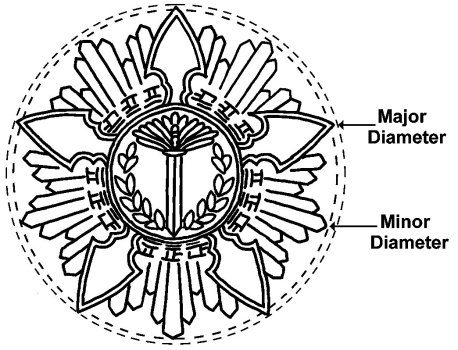
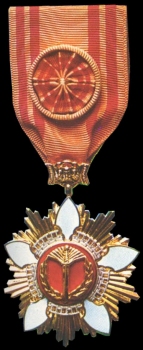
The Order of National Security Merit was established on Feb. 28, 1967 by Presidential Decree #2929. It is conferred upon those who have rendered distinguished service for the national security. It is primarily a non-combat, military award. The 1967 series follows the general European usage of sashes, breast stars, cravats, etc. There were no specific names for each Class, simply a number.
- 1st Class Medal 一등장 (一等章) 일등장. The pendant has a major diameter of 60 mm and a minor diameter is 57 mm. The sash is 80 × 1700 mm. In the Korean legislation, the sash color is described as Vermilion (Chinese red, reddish orange) 주등색, but a brief look at a period sash shows that it is more of a mustard yellow. There are no stripes on the sash. The breast star has a major diameter of 70 mm and a minor diameter of 66 mm. There is a 38 × 10 mm ribbon bar and a round 17 mm lapel pin, both of which are solid vermilion like the sash.
- 1st Class Medal 一등장 (一等章) – Sized for Women 숙녀용. The pendant has a major and a minor diameter of 45 mm. The sash at 70 × 1700 mm. The ribbon bar, lapel pin, and the rest of the sash description are identical to those of the men’s size. The breast star has a major and minor diameter of 50 mm.
- 2nd Class Medal 二등장 (二等章) 이등장. The pendant has a major diameter of 55 mm and a minor diameter of 54 mm. The cravat is 38 × 600 mm with two 7 mm red 적색 stripes, with one on each side of a 22 mm vermilion center stripe. The breast star has a major diameter of 64 mm and a minor diameter of 60 mm. There is a 38 × 10 mm ribbon bar which matches the cravat. The round 17 mm lapel pin also has two red stripes, but there are no measurements given in the legislation.
- 3rd Class Medal 三등장 (三等章) 삼등장. The pendant has a major diameter of 52 mm and a minor diameter of 50 mm. The cravat is 38 × 600 mm with two 5 mm red stripes, one on each side of a 20 mm vermilion center stripe. There is no breast star. There is a 38 × 10 mm ribbon bar which matches the cravat. The round 17 mm lapel pin also has two red stripes, but there are no measurements given in the legislation.
- 4th Class Medal 四등장 (四等章) 사등장. The 4th Class is a breast medal, with the pendant having a major diameter of 48 mm and a minor diameter of 46 mm. The breast ribbon is 38 × 11 mm (as found in the original legislation, probably 100 or 110 mm) with four 2 mm red stripes, two on each side of a 20 mm orange center. There is a rosette on the drape. There is a 38 × 10 mm ribbon bar which matches the cravat. The round 17 mm lapel pin also has four red stripes, with two on each side of the center, but there are no measurements given in the legislation.
- 5th Class Medal 五등장 (五等章) 오등장. The 5th Class is a breast medal, with the pendant having a major diameter of 44 mm and a minor diameter of 40 mm. The breast ribbon is 38 × 11 mm (as found in the original legislation, probably 100 or 110 mm) with two 2 mm red stripes, one on each side of a 24 mm vermilion center stripe. There is no rosette on the drape. There is a 38 × 10 mm ribbon bar which matches the cravat. The round 17 mm lapel pin also has two red stripes, one on each side of the center stripe, but there are no measurements given in the legislation.

1969 SERIES
On Dec. 19, 1969 the Order of National Security Merit was changed by Presidential Decree #4466. The 1969 Series is identical to the 1967 Series in all respects except one. The round 17 mm lapel pin of the 1967 series is replaced with a rectangular 12 × 8 mm lapel pin. Without the lapel pin, or a cased award with the fitted space for a lapel pin, there is no way to determine if a medal is from the 1967 or 1969 series.
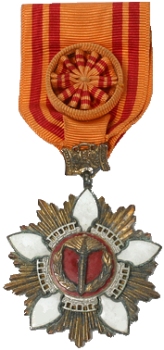
1970 SERIES
The Classes for the Order of National Security Merit were renamed under Decorations Law Enforcement Decree #5388, on Nov. 17, 1970. For identification purposes, the reverse of the badges and breast stars have the new names, but the obverses still retain the older design and are the same size as the 1967 and the 1969 Series. There are no changes to the ribbon colors or stripe patterns.1
The new class names are:
- Tong-il Medal 통일장 (統一章), Unity (as a unifier of North and South)
- Gugseon Medal 국선장 (國仙章), Country Virtue (Virtue of the nation)
- Cheonsu Medal 천수장 (天授章), Long Life
- Sam-il Il Medal 삼일장 (三一章), Literally, “Three One” (a reference to the March 1st National Independence Movement in 1919 삼일민족독립운동, against the Japanese occupation of Korea)
- Gwangbog Medal 광복장 (光復章), Glorious Restoration; the restoration of independence to a country. The term 광복 (光復) “return of the light,” is used in Korea and China and carries the connotation of re-gaining independence. August 15th (8.15) is called Gwang bok chŏl 광복절/光復節, literally “the day of the return of the light”. August 15th is primarily associated with the liberation 해방 (解放) of Korea from Japanese colonial rule on 8.15.1945, but, it is also the day that, in 1948, the Republic of Korea came into existence. The date was deliberately picked as a means of snubbing Japan. In the context of ‘liberation from Japanese colonial rule’, Gwang bok chŏl is the only mutually observed holiday of both North and South Korea. The double-meaning of 8.15 is non-existent in a North Korean context, the foundation of the North Korean state is celebrated on September 9, and termed the ‘Day of the Establishment of the People’s Government’ (인민정권 창건일/人民政權 創建日).
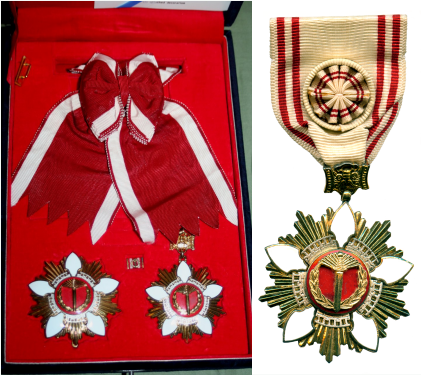
1971 SERIES
The Order of National Security Merit was altered on June 30, 1971, by Presidential Decree #5688. There were several changes made, all of which involved the colors of the ribbons, ribbon bars and lapel pins. The First Class is a red ribbon with white stripes, while the remaining classes are white ribbons with red stripes. There were no changes to the appearance or to the dimensions of the pendants and breast stars.
- Tong-il Medal 통일장 (統一章) The 80 × 1,700 mm sash has two 10 mm white 백색 stripes, with one on each side of a 56 mm red 적색 center stripe. The ribbon bar has twp 6 mm white stripes, one on each side of a 24 mm red center stripe.
- Tong-il Medal 통일장 (統一章) – Sized for Women 숙녀용. The sash is 65 × 1700 mm and has two 10 mm white stripes, one on each side of a 41 mm red center stripe.
- Gugseon Medal 국선장 (國仙章). The cravat is 38 × 600 mm in size and has eight 2 mm red stripes, four on each side of a 12 mm white center stripe.
- Cheonsu Medal 천수장 (天授章). The cravat is 38 × 600 mm in size. It has six 1.5 mm red stripes, with three on each side of a 19 mm white center stripe.
- Sam-il Medal 삼일장 (三一章). The breast medal ribbon is 38 × 50 mm in size. It has four 2 mm red stripes, with two on each side of a 20 mm white center stripe. There is a rosette in the center of the drape, but there is no rosette on the ribbon bar.
- Gwangbog Medal 광복장 (光復章). The breast medal ribbon is 38 × 50 mm in size. It has two 2.5 mm red stripes, with one on each side of a 29 mm white center stripe. There is no rosette on the drape.
1973 SERIES
On Nov. 1, 1973, the design of the Order of National Security Merit was changed by Presidential Decree #6916 (Decorations Law Enforcement Decree). Except for the rosette on the 5th Class, this series follows the general European usage of sashes, breast stars, etc. Each class has a 38 × 10 mm ribbon bar and a 12 × 8 mm lapel pin. The Taeguk symbol is found on the lapel pins, but not on the ribbon bars. Except for the 1st Class, the pattern of stripes found on the ribbons of the lower 4 classes is also found on their respective ribbon bars and lapel pins. The ribbon bars are 38 × 10 mm and the lapel pins are 12 × 8 mm. There is a Taeguk symbol in the center of the lapel pin, but not on the ribbon bar. All classes have the same ribbon and stripe colors, but the legislation uses different terms for the 1st Class purple as opposed to the other four classes. (In the following series, this changes when each class is assigned a different ribbon color.) This can be an extremely challenging series to find. It was issued for less than one year, and any member of the military who had received this award during that year, and was still on active duty in 1974, probably had it changed when the newer series came into existence. Retirees in 1973 who received this series, are the only ones who generally would not have changed to the newer series, but it was an option that was available to them.
The Demons face on the suspension device refers to the national defense. The six white wings of the cross symbolize stout power. The arrowheads indicate protection of the country from foreign forces. The smaller red wings indicate the brilliance of the hard work. The Trigrams and the Taeguk at the center symbolize the Republic of Korea.
NOTE: The six smaller inner points are described in the legislation as 시촉 meaning “deep point, arrow, or arrow head”. I will be using the term “Minor Diameter” to reference these points.
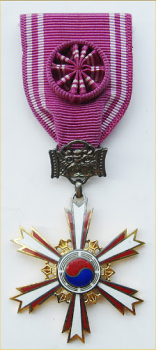
- Tong-il Medal 통일장 (統一章). The major diameter of the pendant is 60 mm, the minor diameter is 30 mm. The pendant weighs 30.7 grams. It is mounted on an 80 × 1700 mm scarlet 홍색 sash. The suspension is 20 × 12 mm. There are no stripes on the sash. The breast star has a major diameter of 71 mm, a minor diameter of 35 mm and weighs 42.7 grams. Both the ribbon bar and the lapel pin have two wide white 백색 stripes, one on each side of a scarlet center stripe, but there are no width dimensions given in the legislation.
- Tong-il Medal 통일장 (統一章) – Sized for Women 숙녀용. Except for size, the women’s 1st Class is identical to the men. The pendant has a major diameter of 50 mm, a minor dimension of 25 mm, and weighs 24 grams. It is suspended from a 65 × 1700 mm purple sash. The breast star has a major diameter of 55 mm, a minor dimension of 29 mm and weighs 29.3 grams. Both the ribbon bar and the lapel pin have two wide white stripes, one on each side of a purple center stripe, but there are no width dimensions given in the legislation.
- Gugseon Medal 국선장 (國仙章). The 2nd Class pendant has a major diameter of 55 mm, a minor diameter of 29 mm and weighs 29.3 grams. It is suspended from a 38 × 600 mm cravat. The ribbon is purple 자섹 with eight 1.5 mm white 백 stripes, four on each side of a 13 mm center. The breast star has a major diameter of 60 mm, a minor diameter of 30 mm and weighs 30.7 grams. The colors on the ribbon bar and lapel pin mimic the cravat, but there are no width dimensions in the legislation.
- Cheonsu Medal 천수장 (天授章). The 3rd Class pendant has a major diameter of 50 mm, a minor dimension of 25 mm and weighs 24 grams. It is mounted on a 38 × 600 mm cravat. The ribbon is purple with six 1.5 mm white stripes, three on each side of a 17 mm center. There is no breast star. Both the ribbon bar and the lapel pin have the same stripe pattern as the cravat, but there are no width dimensions given in the legislation.
- Sam-il Medal 삼일장 (三一章). The 4th Class is a breast medal. The pendant has a major diameter of 50 mm, a minor diameter of 25 mm and weighs 24 grams. It is suspended from a 38 × 100 mm breast ribbon. The ribbon is purple and has four 1.5 mm white stripes, two on each side of a 24 mm white center stripe. There is a rosette on the drape. Both the ribbon bar and the lapel pin have the same stripe pattern as the cravat, but there are no width dimensions given in the legislation.
- Gwangbog Medal 광복장 (光復章). The 5th Class is a breast medal. The pendant has a major diameter of 50 mm, a minor diameter of 25 mm and weighs 24 grams. It is suspended from a 38 × 100 mm ribbon. The ribbon is purple and has two 2 mm white stripes, one on each side of a 30 mm center. There is a rosette on the drape. Both the ribbon bar and the lapel pin have the same stripe pattern as the cravat, but there are no width dimensions given in the legislation.
1974 SERIES
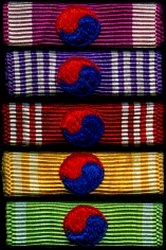
The Order of National Security Merit was modified on Oct. 23, 1974 by Presidential Decree #7289 (Decorations Law Enforcement Decree). All the physical dimensions remain the same, including sizes, style of ribbon used, etc. remain the same. The primary change is the colors used on the ribbons, ribbon bars and lapel pins have changed. The color for the stripes on all 5 classes is still white 백색, but each Class now has a different primary ribbon color. These are the same color ribbons that you see in the current series.
Namely:
- For the Tong-il Medals 통일장 (統一章), on both the men and women’s sizes, there is no change to the ribbon colors. It is still scarlet 홍색.
- For the Gugseon Medal 국선장 (國仙章), the new ribbon color is purple 보라색,
- For the Cheonsu Medal 천수장 (天授章), the new ribbon color is red 적색,
- For the Sam-il Medal 삼일장 (三一章), the new ribbon color is pale-yellow 담황색, and
- For the Gwangbog Medal 광복장 (光復章), the new ribbon color is chartreuse 연두색.

There is also a change to the ribbon bars for multiple awards of the same class of medal. When an individual receives his first award of a particular class, the Taeguk symbol that is in the center of all the ribbon bar is visible. A second awarding of the same class of medal is distinguished with the addition of a Mugunghwa flower being placed on top of the Taeguk. A Third award is distinguished with a Mugunghwa flower on each side of the Taeguk, but not in the center, leaving the Taeguk symbol exposed. There is no mention of what is done for a 4th award of the same class of medal. This system is used on all five classes. This system is also used on the Order of Military Merit.
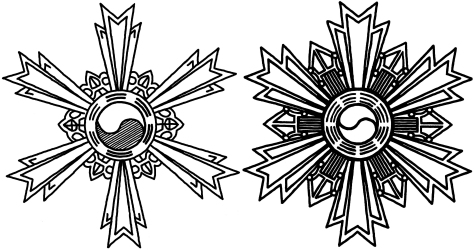
1974 – A SERIES
There is a problem between the 1973, 1974 and 1984 Decorations Law Enforcement Decrees. The 1973 decree authorized the pendants and breast stars with the smaller inner points (시촉 meaning “deep point, arrow, or arrow head”), and the 1984 legislation shows the small points as being much larger. The 1974 legislation is the only legislation between 1973 and 1984, but it does not authorize the larger points. In the 10 years between 1974 and 1984, there should be dozens of medals showing the smaller point pendants/breast stars with the new 1974 ribbon colors. To date, I have only found one picture of a medal with smaller points and the new ribbon colors. This may have been someone who received a 1973 decoration and instead of buying the new design when it came out, that individual may have just changed the ribbon to the new 1974 style.
In 1984, the production numbers on the reverse inscriptions were discontinued. If the 1984 legislation was the point in time, where the inner points were enlarged, there should be no examples of the larger point pendants/breast stars with production numbers. This is simply not the case. There are large numbers of larger point pendants/breast stars with production numbers.
Until it can be established when the change was made, with certainty, I will refer to the larger point pendants/breast stars with production numbers on the reverse as 1974-A Series medals.
1984 SERIES
On Jan. 23, 1984 under Presidential Decree #11336, the pendants for the Order of National Security Merit were officially redesigned to the current style.
- Tong-il Medal 통일장 (統一章). The 1st Class pendant has a major diameter of 70 mm and weighs 69 grams. It is mounted on an 80 × 1800 mm purple 자주색 sash. There are no stripes on the sash. The breast star has a major diameter of 80 mm and weighs 85 grams. The ribbon bar has 1 mm purple edge stripes with two 6 mm white 백색 stripes, one on each side of a 24 mm purple center. The lapel pin is similar, with 1.5 mm white stripes on either side of a 4 mm purple center.
- Tong-il Medal 통일장 (統一章) – Sized for Women 숙녀용. The pendant has a major dimension of 50 mm and weighs 37.5 grams and is suspended from a 65 × 1700 mm purple 자주색 sash. There are no stripes on the sash. The breast star has a major dimension of 55 mm and weighs 43 grams. The ribbon bars and lapel pins are identical to the men’s size.
- Gugseon Medal 국선장 (國仙章). The 2nd Class pendant has a major diameter of 60 mm and weighs 49.5 grams. It is suspended from a blue 청색 38 × 600 mm cravat with eight 1.5 mm white 백색 stripes, four on each side of a 13 mm blue 청색 center stripe. The breast star has a major diameter of 70 mm and weighs 66.5 grams. The ribbon bar has the same stripe width dimensions as the cravat. The lapel pin is similar, with eight 0.2 mm white stripes, with four on each side of a 4 mm blue center stripe.
- Cheonsu Medal 천수장 (天授章). The 3rd Class pendant has a major diameter of 50 mm and weighs 35 grams. It is mounted on a red 적색 38 × 600 mm cravat with six 1.5 mm white 백색 stripes, three on each side of a 19 mm red 적색 center stripe. The ribbon bar has the same stripe width dimensions as the cravat. The lapel pin is similar, with six 0.2 mm white stripes. With three on either side of a 5 mm red center stripe. There is no breast star.
- Sam-il Medal 삼일장 (三一章). The 4th Class is a breast medal. The pendant has a major diameter of 50 mm and weighs 33.5 grams. It is suspended from a 38 × 100 mm breast ribbon. The light or pale yellow 담황색 ribbon has four 1.5 mm white 백색 stripes, two on each side of a 24 mm light yellow center stripe. The ribbon bar has the same stripe width dimensions as the breast ribbon. The lapel pin is similar, with four 0.3 mm white stripes, with two on each side of the light yellow center stripe. There is a rosette on the drape.
- Gwangbog Medal 광복장 (光復章). The 5th Class is a breast medal. The pendant has a major diameter of 50 mm and weighs 33.5 grams. It is suspended from a 38 × 100 mm breast ribbon. The light green (Chartreuse) 연두색 ribbon has two 2 mm white 백색 stripes, one on each side of 30 mm light green center stripe. The ribbon bar has the same stripe width dimensions as the breast ribbon. The lapel pin is similar, with 0.5 mm white stripes on either side of a 5 mm center stripe. There is no rosette on the drape.
CURRENTLY
Since 1984, the Decorations Law Enforcement Decree has been changed 19 times. The current legislation is Decree #30517 and was enacted on March 10, 2020. In the intervening years, the only major change was to the Order of National Security Merit, Tong-il Medal (sized) for Ladies. It was found to be discriminatory and was dropped in 2016.2 There have been minor wording changes concerning the ribbon colors, they are: for the white 백색 stripes, they now use the term 흰색, for blue 청색, they now use the term 파란색, and for red 적색, they now use the term 붉은색. The only actual change in color is to the Sam-il Medal. Instead of pale-yellow 담황색, they now use the term 노란색 meaning yellow. They did not change the word used for light-green (chartreuse) 연두색 that is used to describe the ribbon on the Gwangbog Medal 광복장 (光復章). All the other sizes, patterns, etc., of the 1984 legislation, are still in effect.
The Classes are:
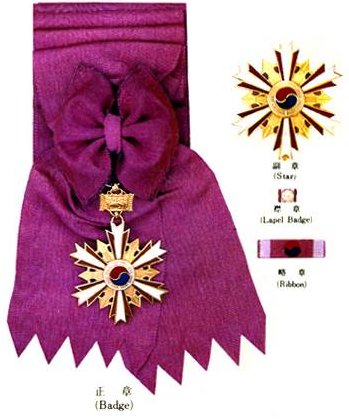
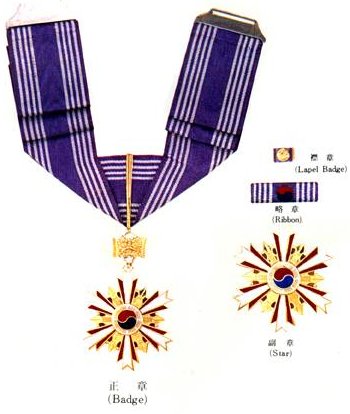

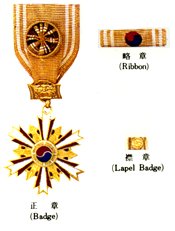
삼일장 (三一章)
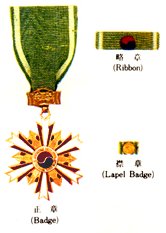
광복장 (光復章)
Footnotes:
- Decorations Law Enforcement Decree #5035, had been issued months earlier, on June 13, 1970. There were no changes to the “Order” of National Security Merit. The only change was a change to the National Security “Merit Medal”.
- Decorations Law Enforcement Decree 상훈법 시행령, Presidential Decree #26838 대통령령 제26838호, dated 2015.12.31 and implemented on 2016.1.1.[시행 2016.1.1.], partial revision 일부개정.
